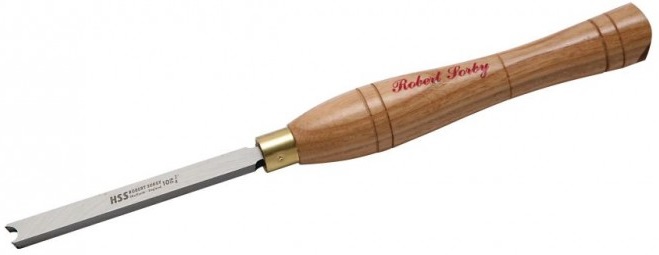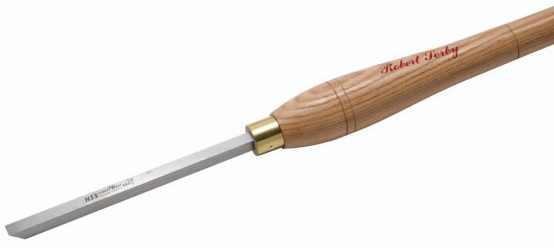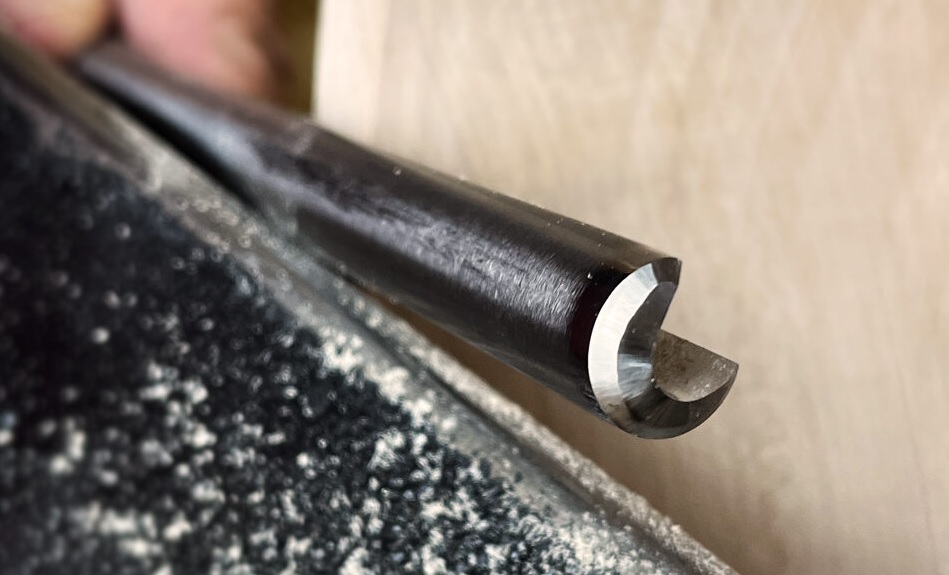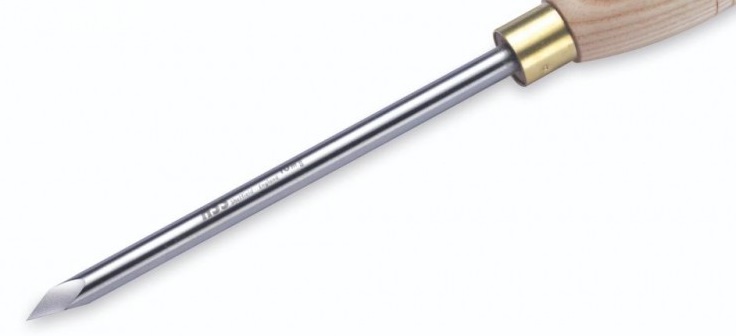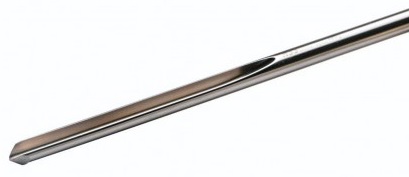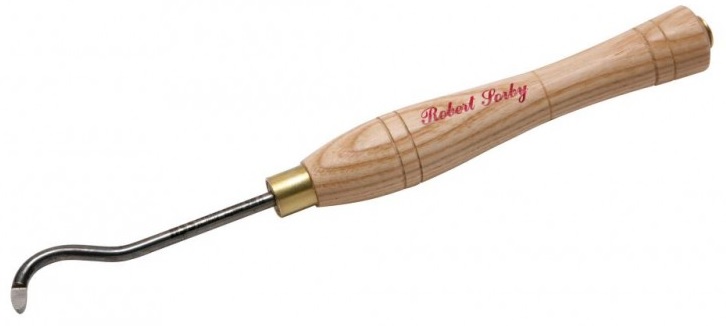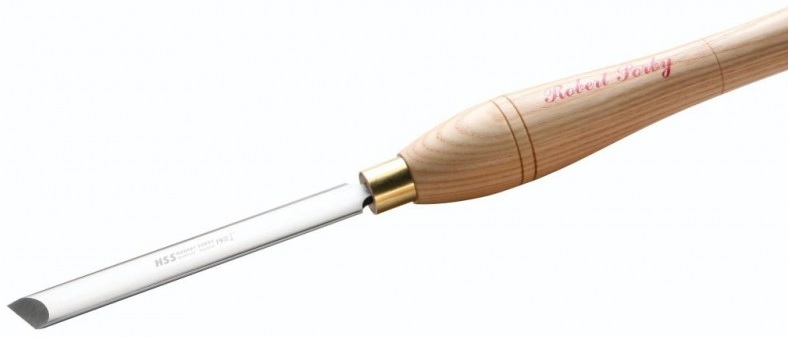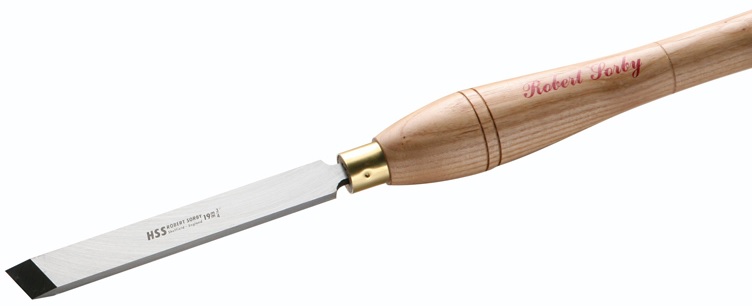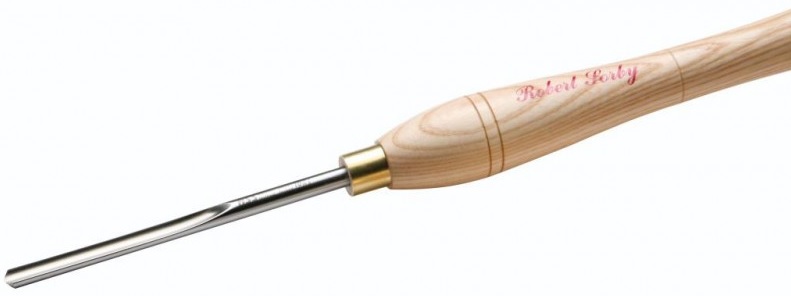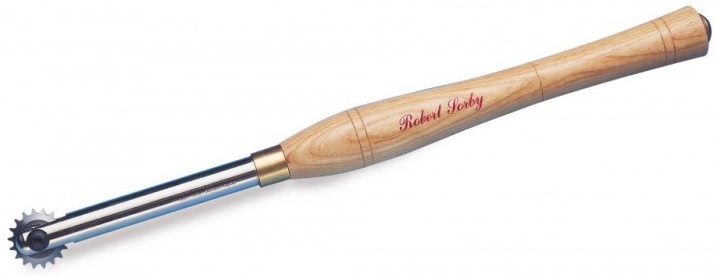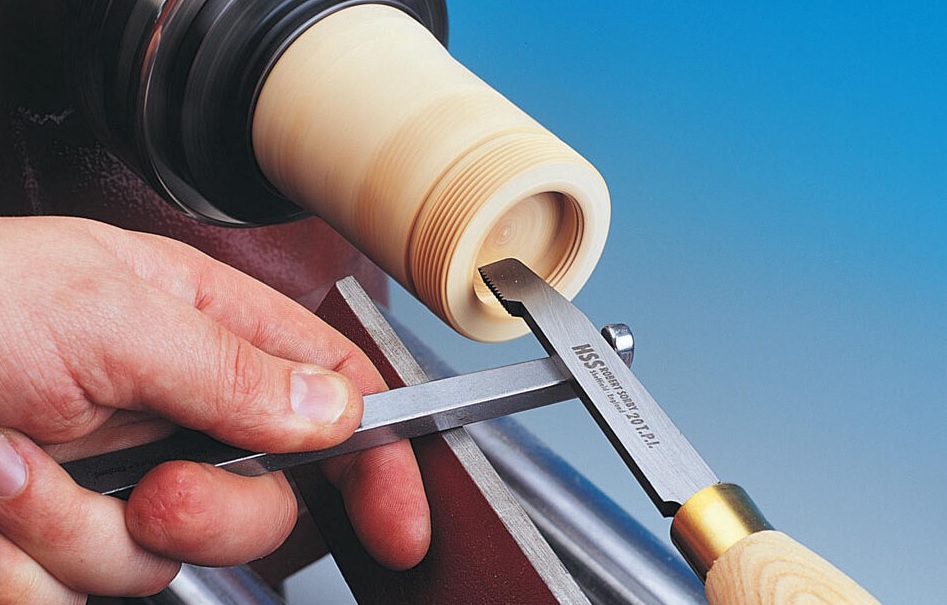Woodturning Tools
Woodturning is a craft that combines creativity with precision, and having the right tools is key to mastering it. Whether you're just starting out or refining your skills, understanding your tools will help you turn wood with confidence and artistry.
Use the shortcuts below to skip to the relevant section:
Bead Forming Tool
A bead forming tool is a specialized woodturning tool designed to cut perfectly shaped beads (rounded decorative ridges) quickly and consistently on spindle work. Unlike using a spindle gouge to form beads manually, this tool simplifies the process and ensures uniform results.
Key Features:
Pre-shaped cutting edge: The tool has a semi-circular or rounded profile that matches the shape of the bead it’s designed to cut.
Flat shaft: Provides stability on the tool rest.
Available in various sizes: Each size corresponds to the diameter of the bead it produces (e.g., 1/4", 3/8", 1/2").
Fast and repeatable bead shaping
Beginner-friendly—less skill required than using a spindle gouge
Produces clean, symmetrical beads with minimal effort
Uses:
Creating decorative beads on spindles, pens, chair legs, balusters, and other turned items.
Adding texture and visual interest to turned projects.
Speeding up repetitive bead work with consistent results.
Bedan Parting Tool
A bedan parting tool is a specialized woodturning tool that combines features of both a parting tool and a scraper, making it particularly useful for cutting square shoulders, forming tenons, and refining flat surfaces.
Key Features:
Rectangular cross-section: Unlike traditional parting tools that are thin or diamond-shaped, the bedan has a wide, flat blade with a rectangular profile.
Sturdy and rigid: Its thickness and shape make it ideal for deeper cuts without flexing or chatter.
Uses:
Cutting tenons for chucking
Squaring shoulders on spindle or bowl work
Making grooves or recesses with flat bottoms
Scraping flat surfaces cleanly
A bottom feeder bowl gouge is a specialized grind on a bowl gouge designed specifically for making clean cuts at the very bottom of a bowl, where traditional gouge grinds can struggle or cause tear-out.
Key Features:
Steeper bevel angle: Typically ground to around 40°–45°, which allows the tool to engage the wood more effectively at the bottom of the bowl without catching.
Short bevel: Helps maintain control in tight spaces and reduces the risk of the tool skating across the surface.
Blunt nose: Unlike swept-back or fingernail grinds, the bottom feeder has a more rounded or blunt nose, which is better suited for cutting flat or nearly flat surfaces.
When turning the inside of a bowl, especially near the centre or bottom, the angle of approach changes. Standard bowl gouges (with a 55°–60° grind) can become awkward or unsafe to use in this area. The bottom feeder gouge solves this by allowing a safe, controlled cut with the bevel rubbing properly against the wood.
Uses:
Final passes at the bottom of a bowl
Smoothing out the transition from side walls to the base
Avoiding tear-out in end grain areas
Bowl Gouge (Standard)
A bowl gouge is a specialized woodturning tool used primarily for shaping and hollowing out bowls on a lathe. It's a type of gouge chisel, but designed specifically for turning curved surfaces and deep interiors.
Key Features:
Deep flute: The groove along the shaft helps remove wood shavings efficiently and allows for smoother cuts.
Curved cutting edge: Ideal for creating smooth, flowing curves inside and outside of bowls.
Swept-back grind (optional): Some bowl gouges have a fingernail or swept-back grind for more versatility in cutting angles.
Robust shaft: Usually thicker and stronger than spindle gouges to handle the stress of bowl turning.
Uses:
Roughing out bowl blanks
Shaping the exterior of a bowl
Hollowing the interior
Refining curves and contours

Detail Point Tool
A detail point tool is a woodturning tool designed for making precise, fine cuts, especially in tight areas or when adding intricate details to a turning project. It’s often used by woodturners for decorative work, sharp transitions, and clean lines.
Key Features:
Pointed tip: Usually ground to a sharp, fine point for accuracy.
Triangular or diamond-shaped cross-section: This shape provides strength and stability while allowing access to tight spaces.
Flat bevels: Often has flat bevels on each side of the point for clean cutting and scraping.
Unlike a skew chisel, which can also make fine cuts but is harder to control, the detail point tool is more forgiving.
It’s not designed for bulk material removal like a bowl gouge, but rather for precision shaping.
Uses:
Creating crisp lines and sharp corners
Adding beads, coves, or other decorative elements
Working in confined areas where larger tools can’t reach
Refining transitions between shapes
Diamond Section Parting Tool
A diamond section parting tool is a type of woodturning parting tool with a diamond-shaped cross-section, designed to reduce friction and heat buildup during cuts, especially when parting off a finished piece.
Key Features:
Diamond-shaped blade: The tool is thicker in the middle and tapers toward the top and bottom edges.
Reduced contact area: Only the narrow top and bottom edges touch the wood, minimizing friction.
Clean, narrow cuts: Ideal for precise parting without binding or burning.
Less heat buildup: The reduced surface contact helps prevent scorching.
Smoother cuts: The shape allows for cleaner separation with less resistance.
Better chip clearance: The tapered edges help eject shavings more easily.
Uses:
Parting off finished pieces from the lathe
Cutting grooves for decorative or functional purposes
Creating tenons or recesses for chucking
Fingernail Bowl Gouge
A fingernail bowl gouge is a type of bowl gouge with a specific grind shape that resembles the curve of a fingernail. This grind is popular among woodturners because it offers versatility, control, and smoother cuts, especially on the outside and inside curves of bowls.
Key Features:
Swept-back wings: The sides of the gouge are ground back, creating a long, curved cutting edge.
Pointed nose: The tip is more acute than a traditional grind, allowing for precise entry into cuts.
Bevel angle: Typically around 55°–60°, which is ideal for general bowl turning.
Versatile cutting: Can perform push cuts, pull cuts, shear scraping, and even delicate finishing cuts.
Smooth transitions: Great for shaping the outside of bowls and making flowing curves.
Improved maneuverability: Easier to control in tight curves and complex shapes.
Uses:
Shaping the exterior of bowls
Hollowing the interior (except the very bottom—where a bottom feeder gouge is better)
Refining curves and transitions
Hollowing Tool
A hollowing tool is a woodturning tool specifically designed for removing material from the inside of hollow forms like bowls, vases, goblets, and closed vessels. These tools allow turners to reach deep into a piece while maintaining control and safety.
Key Features:
Long shaft or arm: Provides reach into deep or narrow openings.
Cutting tip: Often replaceable or adjustable, designed to cut efficiently inside curved surfaces.
Sturdy construction: Built to resist torque and vibration during deep hollowing.
Optional support systems: Some setups include tool rests, steady rests, or laser guides for precision and safety.
Enables creation of complex hollow forms
Reduces risk of catches compared to using gouges in deep areas
Can be paired with depth gauges or laser systems for precision
Uses:
Hollowing out bowls, vessels, and urns
Creating thin-walled forms
Reaching into tight or deep interiors that gouges can't access
Oval Skew Chisel
An oval skew chisel is a variation of the traditional skew chisel used in woodturning, especially for spindle work. It has a rounded (oval) shaft instead of a flat one, which offers several advantages in terms of handling and control.
Key Features:
Oval cross-section: The shaft is rounded on the sides, making it easier to roll and maneuver.
Skewed cutting edge: Like a standard skew chisel, the cutting edge is angled (typically 60°–70°).
Beveled edges: Sharpened on both sides for clean slicing cuts.
Advantages over flat skew chisels include: Easier to roll - The oval shape helps the tool glide smoothly when making curved cuts like beads. Less prone to catching - The rounded profile makes it more forgiving for beginners. Improved control - Especially helpful when doing fine detail work or planing cuts.
Uses:
Planing cuts for smooth finishes
Beads and coves on spindle work
V-cuts, shoulders, and tenons
Trimming ends and refining shapes
A parting tool is a woodturning tool used primarily for cutting off (parting) a finished piece from the waste wood or for making precise grooves in a turning project.
Key Features:
Thin blade: Typically narrow to reduce friction and prevent binding in the cut.
Flat cutting edge: Designed for clean, straight cuts across the grain.
Uses:
Separating a turned piece from the lathe-mounted blank
Creating tenons for chucking
Cutting precise grooves for decorative or functional purposes
Establishing depth markers for shaping
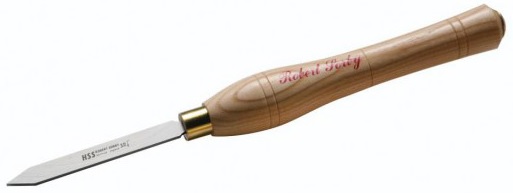
Ring Tool
A ring tool is a specialized woodturning tool used primarily for hollowing and refining the interior surfaces of bowls, vessels, and other hollow forms. It’s especially useful for shear scraping and producing very smooth finishes on the inside of curved surfaces.
Key Features:
Ring-shaped cutter: The cutting edge is formed from a hardened steel ring, often sharpened on the inside edge.
Mounted on a shaft: The ring is attached to a steel shaft or bar, which is held in a handle like other turning tools.
Scraping action: It works by scraping rather than slicing, which makes it more controllable in delicate hollowing tasks.
Produces very smooth finishes, especially on end grain.
Less aggressive than a gouge—great for delicate work.
Can reach into tight or deep areas inside vessels.
Uses:
Hollowing bowls and vessels, especially in end grain
Finishing interior surfaces with minimal tear-out
Refining curves where gouges might chatter or dig in
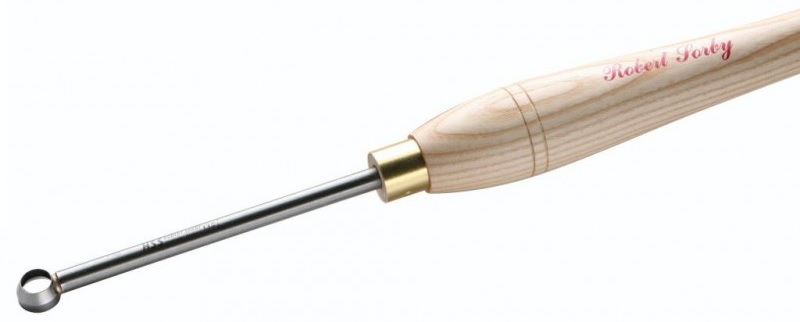
Scraper
A scraper tool is used to refine shapes, smooth surfaces, and remove small imperfections in woodturning projects. Unlike gouges, which cut with a slicing action, scrapers work by scraping the wood surface, making them ideal for delicate finishing work. There are several types of woodturning scrapers, each designed for specific tasks like smoothing, refining, or shaping different parts of a turning project. Here's a breakdown of the most common types:
Round Nose Scraper
Shape: Rounded cutting edge
Use: Ideal for smoothing the interior curves of bowls and vessels
Best for: Hollow forms and concave surfaces
Square Nose Scraper
Shape: Straight, flat edge
Use: Used for flattening surfaces, refining shoulders, and making straight cuts
Best for: Spindle work and flat-bottomed recesses
Diamond Point Scraper
Shape: Pointed tip with angled sides (like a diamond)
Use: Great for tight corners, detail work, and sharp transitions
Best for: Decorative grooves and fine detailing
Curved or Radius Scraper
Shape: Gently curved cutting edge
Use: Used for refining gentle curves and transitions
Best for: Bowls and vessels with flowing contours
Inside Radius Scraper
Shape: Curved inward (concave)
Use: Designed for inside curves, especially in bowl interiors
Best for: Smoothing the inside bottom of bowls
Negative Rake Scraper
Shape: Has a secondary bevel on top of the cutting edge
Use: Provides a gentler, more controlled cut with less tear-out
Best for: Finishing cuts on hardwoods, resins, or end grain
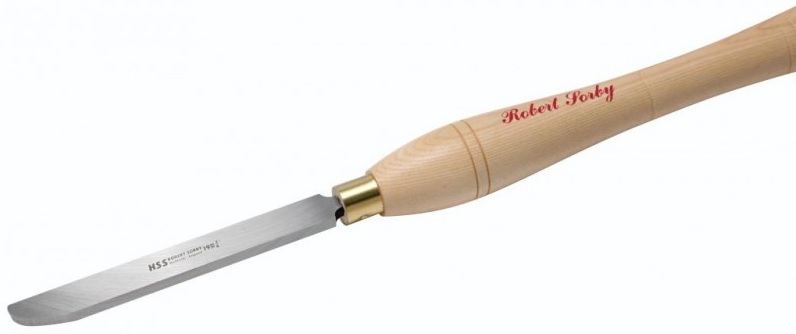
Skew Chisel (Standard)
A skew chisel is a versatile woodturning tool primarily used in spindle turning to create smooth surfaces, crisp details, and precise cuts. It’s known for its ability to produce clean finishes straight off the tool, often requiring little to no sanding.
Key Features:
Flat blade: Usually rectangular in cross-section.
Angled cutting edge: The edge is ground at a skewed angle (typically 60°–70°), hence the name.
Beveled edges: Both sides are beveled to form a sharp cutting edge.
Produces razor-smooth finishes.
Excellent for fine detail work.
Can perform a variety of cuts with one tool.
Uses:
Planing cuts for smooth surfaces
V-cuts and beads for decorative details
Shoulders and tenons for joinery
Trimming ends and refining shapes
Spindle Gouge
A spindle gouge is a woodturning tool specifically designed for shaping and detailing spindle work, projects where the grain runs parallel to the lathe bed, such as chair legs, table legs, pens, and other long, narrow items.
Key Features:
Shallow flute: Compared to a bowl gouge, the flute is narrower and less deep, offering more control for fine cuts.
Smaller diameter: Typically lighter and more nimble than bowl gouges.
Beveled edge: Ground to a bevel angle around 35°-45°, ideal for slicing cuts along the grain.
Excellent for fine detail work
Easier to control on long grain wood
Produces clean, smooth cuts with minimal tear-out
Uses:
Shaping beads, coves, and fillets
Refining curves and transitions
Detailing spindle projects
Smoothing surfaces with controlled cuts
Spindle Roughing Gouge
A spindle roughing gouge is a woodturning tool designed specifically for roughing out spindle blanks, shaping square or irregular pieces of wood into smooth, round cylinders on the lathe. A spindle roughing gouge is not designed for bowl turning. Using it on face grain can be dangerous as it may catch or even break due to the forces involved.
Key Features:
Wide, U-shaped flute: Allows for efficient removal of large amounts of material.
Thick blade: Provides strength and stability during aggressive cuts.
Straight edge: Ideal for cutting along the grain in spindle turning.
Fast and efficient for rough shaping
Easy to control on spindle work
Reduces wear on finer tools by handling the heavy cuts
Uses:
Turning spindles, table legs, chair parts, and other long, narrow projects.
Quickly removing corners from square stock to make it round.
Preparing blanks for finer shaping with detail tools.
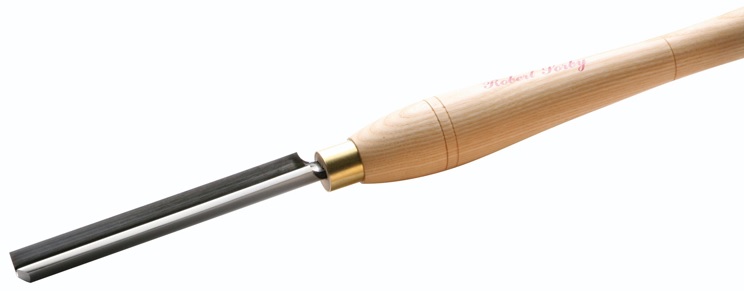
Spiralling Tool
A spiralling tool is a woodturning tool used to create decorative spiral patterns or textured designs on the surface of a turned piece, typically on spindles, boxes, or platters. It’s a favorite among turners who want to add visual interest and tactile detail to their work.
Key Features:
Rotating cutter wheel: The tool has a small, hardened steel wheel with sharp teeth that spins as it contacts the wood.
Adjustable handle or shaft: Allows you to change the angle and pressure for different effects.
Interchangeable cutters: Some tools come with multiple wheels for different textures (spirals, knurls, rope patterns, etc.).
Adds professional-looking decoration with minimal effort
Customizable patterns depending on angle, speed, and pressure
Works well on hardwoods and dense materials
Uses:
Creating spiral grooves around spindles or box lids
Adding textured bands to bowls or platters
Enhancing grip areas on tool handles or pens
Making rope-like or knurled patterns
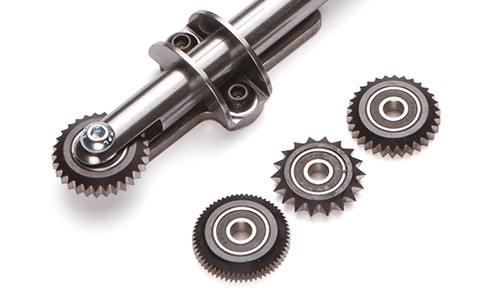
Texturing Tool
A texturing tool in woodturning is a specialized tool used to create decorative surface patterns on turned wood pieces. It’s designed to add visual and tactile interest such as dimples, knurls, or rope-like textures, without removing large amounts of material.
Key Features:
Rotating cutter wheel: A small, hardened steel wheel with sharp edges that spins as it contacts the wood.
Mounted on a handle or shaft: Allows for controlled application of pressure and angle.
Interchangeable cutters: Some tools come with different wheels for various textures (e.g., fine, coarse, spiral).
Easy to use for consistent, repeatable patterns
Works well on hardwoods and dense materials
Adds a professional finish with minimal effort
Uses:
Adding texture to box lids, handles, spindles, and platters
Enhancing grip areas on functional items like tool handles or pens
Creating decorative bands or accents
Thread Cutter
A thread cutter is a specialized tool used to cut internal or external threads into wooden pieces, allowing them to screw together, such as a lid fitting onto a box or a handle attaching to a base.
Key Features:
Threading blades or cutters: Shaped to match standard thread profiles (e.g., 16 TPI, 20 TPI).
Internal and external cutters: Usually sold as a pair. One for cutting threads inside a hole, the other for cutting threads on a tenon.
Guided handle: Helps maintain consistent alignment and pressure during cutting.
Allows for precise, repeatable threading
Works well on dense hardwoods and threading-friendly materials like boxwood or lignum vitae
Adds a professional touch to turned projects
Uses:
Making threaded lids for boxes or jars
Creating screw-on joints for multi-part turnings
Adding functional or decorative threads to turned items
 Price
Price




 01726 828 388
01726 828 388


